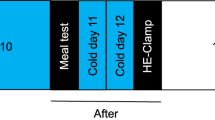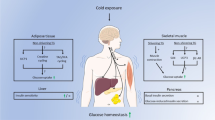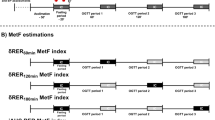Abstract
Cold acclimation increases insulin sensitivity, and some level of muscle contraction appears to be needed for provoking this effect. Here 15 men and (postmenopausal) women with overweight or obesity, the majority of whom had impaired glucose tolerance, were intermittently exposed to cold to induce 1 h of shivering per day over 10 days. We determined the effect of cold acclimation with shivering on overnight fasted oral glucose tolerance (primary outcome) and on skeletal muscle glucose transporter 4 translocation (secondary outcome). We find that cold acclimation with shivering improves oral glucose tolerance, fasting glucose, triglycerides, non-esterified fatty acid concentrations and blood pressure. Cold acclimation with shivering may thus represent an alternative lifestyle approach for the prevention and treatment of obesity-related metabolic disorders. ClinicalTrials.gov registration: NCT04516018.
This is a preview of subscription content, access via your institution
Access options
Access Nature and 54 other Nature Portfolio journals
Get Nature+, our best-value online-access subscription
$32.99 / 30 days
cancel any time
Subscribe to this journal
Receive 12 digital issues and online access to articles
$119.00 per year
only $9.92 per issue
Buy this article
- Purchase on SpringerLink
- Instant access to full article PDF
Prices may be subject to local taxes which are calculated during checkout



Similar content being viewed by others
Data availability
The generated and analysed datasets of the current study are not publicly available. De-identified and processed data can be requested from the corresponding authors for academic purposes after completing a signed data access form. The study team will only provide de-identified data to protect participant privacy. The study protocol is provided with the publication. Skeletal muscle gene expression data have been deposited in GEO under accession code GSE271452. Source data are provided with this paper.
References
Hanssen, M. J. et al. Short-term cold acclimation improves insulin sensitivity in patients with type 2 diabetes mellitus. Nat. Med. 21, 863–865 (2015).
Remie, C. M. E. et al. Metabolic responses to mild cold acclimation in type 2 diabetes patients. Nat. Commun. 12, 1516 (2021).
Vallerand, A. L. et al. Plasma glucose turnover during cold stress in humans. J. Appl. Physiol. (1985) 78, 1296–1302 (1995).
Haman, F. et al. Partitioning oxidative fuels during cold exposure in humans: muscle glycogen becomes dominant as shivering intensifies. J. Physiol. 566, 247–256 (2005).
Blondin, D. P. et al. Contributions of white and brown adipose tissues and skeletal muscles to acute cold-induced metabolic responses in healthy men. J. Physiol. 593, 701–714 (2015).
Abdul-Ghani, M. A. et al. Muscle and liver insulin resistance indexes derived from the oral glucose tolerance test. Diabetes Care 30, 89–94 (2007).
Eyolfson, D. A. et al. Measurement and prediction of peak shivering intensity in humans. Eur. J. Appl. Physiol. 84, 100–106 (2001).
Cao, C. et al. Increased plasma fatty acid clearance, not fatty acid concentration, is associated with muscle insulin resistance in people with obesity. Metabolism 132, 155216 (2022).
Ferrannini, E. et al. Effect of fatty acids on glucose production and utilization in man. J. Clin. Invest. 72, 1737–1747 (1983).
Lawler, P. R. et al. Real-world risk of cardiovascular outcomes associated with hypertriglyceridaemia among individuals with atherosclerotic cardiovascular disease and potential eligibility for emerging therapies. Eur. Heart J. 41, 86–94 (2020).
Hanssen, M. J. et al. Short-term cold acclimation recruits brown adipose tissue in obese humans. Diabetes 65, 1179–1189 (2016).
Nascimento, E. B. M. et al. Comparative transcriptome analysis of human skeletal muscle in response to cold acclimation and exercise training in human volunteers. BMC Med. Genomics 13, 124 (2020).
van der Lans, A. A. et al. Cold acclimation recruits human brown fat and increases nonshivering thermogenesis. J. Clin. Invest. 123, 3395–3403 (2013).
Russell, R. D. et al. Oral glucose challenge impairs skeletal muscle microvascular blood flow in healthy people. Am. J. Physiol. Endocrinol. Metab. 315, E307–E315 (2018).
Carpentier, A. C. & Blondin, D. P. Human brown adipose tissue is not enough to combat cardiometabolic diseases. J. Clin. Invest. 133, e175288 (2023).
Mensink, M. et al. Lifestyle intervention according to general recommendations improves glucose tolerance. Obes. Res. 11, 1588–1596 (2003).
Sellers, A. J. et al. The effect of cold exposure with shivering on glucose tolerance in healthy men. J. Appl. Physiol. 130, 193–205 (2021).
van Ooijen, A. M. et al. Cold-induced heat production preceding shivering. Br. J. Nutr. 93, 387–391 (2005).
Blondin, D. P. et al. Four-week cold acclimation in adult humans shifts uncoupling thermogenesis from skeletal muscles to brown adipose tissue. J. Physiol. 595, 2099–2113 (2017).
Boettcher, C. E., Ginn, K. A. & Cathers, I. Standard maximum isometric voluntary contraction tests for normalizing shoulder muscle EMG. J. Orthop. Res. 26, 1591–1597 (2008).
Kong, P. W. & van Haselen, J. Revisiting the influence of hip and knee angles on quadriceps excitation measured by surface electromyography. Int. Sportmed. J. 11, 313–323 (2010).
Weir, J. B. New methods for calculating metabolic rate with special reference to protein metabolism. J. Physiol. 109, 1–9 (1949).
Brouwer, E. On simple formulae for calculating the heat expenditure and the quantities of carbohydrate and fat oxidized in metabolism of men and animals, from gaseous exchange (oxygen intake and carbonic acid output) and urine-N. Acta. Physiol. Pharmacol. Neerl 6, 795–802 (1957).
Golay, A. et al. Glucose-induced thermogenesis in nondiabetic and diabetic obese subjects. Diabetes 31, 1023–1028 (1982).
Dill, D. B. & Costill, D. L. Calculation of percentage changes in volumes of blood plasma and red cells in dehydration. J. Appl. Physiol. 37, 247–248 (1974).
Bergström, J., Hermansen, L., Hultman, E. & Saltin, B. Diet muscle glycogen and physical performance. Acta. Physiol. Scand. 71, 140–150 (1967).
Schneider, C. A., Rasband, W. S. & Eliceiri, K. W. NIH Image to ImageJ: 25 years of image analysis. Nat. Methods 9, 671–675 (2012).
Acknowledgements
This research was supported by the Netherlands Organisation for Health Research and Development (ZonMw) programme for translational research and Diabetes Fonds (project number 95105007). A grant from the Nutrim NWO Graduate Program was also awarded to S.M.M.B. The authors thank P. Schoffelen, M. Souren and W. Bijnens for their technical support, and E. E. Tapia, S. N. González, M. Buitinga and F. Bosschee for their assistance with the muscle biopsies. The authors thank all participants for their participation.
Author information
Authors and Affiliations
Contributions
A.J.S., S.M.M.B., H.P., P.S., J.H. and W.D.M.L conceived and designed the research. A.J.S., S.M.M.B., D.H., E.M., G.S., A.G. and J.A.J. performed experiments. A.J.S., S.M.M.B., R.B., E.M., G.S., A.G., J.A.J. and G.H. analysed data. A.J.S., S.M.M.B., R.B., H.P., T.W., E.K., G.H., S.K., P.S., J.H. and W.D.M.L. interpreted results. A.J.S. and S.M.M.B. wrote the original paper draft; A.J.S., S.M.M.B., R.B., H.P., S.K., M.K.C.H., P.S., J.H. and W.D.M.L. edited and revised the paper. All authors approved the final paper version.
Corresponding authors
Ethics declarations
Competing interests
The authors declare no conflicts of interest.
Peer review
Peer review information
Nature Metabolism thanks Jose Galgani and the other, anonymous, reviewer(s) for their contribution to the peer review of this work. Primary Handling Editor: Ashley Castellanos-Jankiewicz, in collaboration with the Nature Metabolism team.
Additional information
Publisher’s note Springer Nature remains neutral with regard to jurisdictional claims in published maps and institutional affiliations.
Extended data
Extended Data Fig. 1 Effects of one cold exposure with shivering on fasting plasma glucose (A), plasma glucose during an OGTT (B), glucose AUC (C) and iAUC (D), 2-hour glucose concentration (E), fasting plasma insulin (F), plasma insulin during an OGTT (G), and insulin AUC (H) and iAUC (I).
Mean ± SD and individual responses are presented, n = 15. Data in panels (A), (C), (D), (E), (H), and (I) were analysed with a two-sided paired t-test. Data in panel (F) was analysed with a two-sided Wilcoxon signed-rank test. AUC, area under the curve; iAUC, incremental area under the curve; OGTT, oral glucose tolerance test.
Extended Data Fig. 2 Effects of one cold exposure with shivering on energy expenditure (A) and substrate oxidation (B-D) at baseline, and energy expenditure (E), substrate oxidation (F-H), and glucose-induced thermogenesis (I) during an OGTT.
Mean ± SD and individual responses are presented, n = 14. Data in panels (A), (D), and (I) were analysed with two-sided paired t-tests. Data in panels (B) and (C) were analysed with two-sided Wilcoxon signed-rank test. Data in panels (E), (F), (G), and (H) were analysed with a two-way repeated measures ANOVA with Bonferroni post-hoc analyses to assess differences between groups. CHO, carbohydrate; OGTT, oral glucose tolerance test; RER, respiratory exchange ratio.
Extended Data Fig. 3 Effects of cold acclimation on energy expenditure (A) and substrate oxidation at baseline (B-D), and energy expenditure (E), substrate oxidation (F-H) and glucose-induced thermogenesis (I) during an OGTT.
Mean ± SD and individual responses are presented, n = 14. Data in panels (A), (B), (D), and (I), were analysed with two-sided paired t-tests. Data in panel (C) was analysed with a two-sided Wilcoxon signed-rank test. Data in panels (E), (F), (G), and (H), were analysed with a two-way repeated measures ANOVA with Bonferroni post-hoc analyses to assess differences between groups. CHO, carbohydrate; OGTT, oral glucose tolerance test; RER, respiratory exchange ratio.
Extended Data Fig. 4 Effects of one cold exposure with shivering on fasting serum NEFA (A), serum NEFA during an OGTT (B), NEFA AUC (C) and iAUC (D), and fasting serum triglycerides (E).
Mean ± SD and individual responses are presented, n = 15. Data in panels (A) and (C) were analysed with a two-sided paired t-test. Data in panels (D) and (E) were analysed with a two-sided Wilcoxon signed-rank test. AUC, area under the curve; iAUC, incremental area under the curve; NEFA, non-esterified fatty acid; OGTT, oral glucose tolerance test.
Extended Data Fig. 5 Effects of cold acclimation on skeletal muscle glycogen concentration (A) and GLUT4 content (B-E). Representative images of GLUT4 staining with type 1 fibres stained green (B) and the membranes with caveolin (blue), total GLUT4 content (C), GLUT4 at the membrane (D), and GLUT4 in the cytosol (E).
Mean ± SD and individual responses are presented, n = 15. Data in panels (C), (D), and (E) were analysed with a two-sided paired t-test. Data in panel (A) was analysed with a two-sided Wilcoxon signed-rank test.
Extended Data Fig. 6 Effects of one cold exposure with shivering on skeletal muscle GLUT4 content (A-D). Representative images of GLUT4 staining with type 1 fibres stained green (A) and the membranes with caveolin (blue), total GLUT4 content (B), GLUT4 at the membrane (C), and GLUT4 in the cytosol (D).
Mean ± SD and individual responses are presented, n = 13. Data in panels (B), (C), and (D) were analysed with a two-sided paired t-test.
Extended Data Fig. 7 Effects of cold acclimation on the human skeletal muscle transcriptome, volcano plot (A), GSEA on GO-Biological Process terms (B), and KEGG taxonomy (C) of the comparison before and after cold acclimation.
The top 15 upregulated and downregulated gene sets in the 15 participants are shown. Differentially expressed genes were analysed by empirical Bayes moderation with two-sided paired t-tests, unadjusted for multiple comparisons, and defined as significantly changed when p ≤ 0.01 and log2FC > 1.5.
Extended Data Fig. 8 Effects of one cold exposure with shivering on resting systolic (A) and diastolic (B) blood pressure and heart rate (C).
Mean ± SD and individual responses are presented, n = 15. Data in panels (A), (B), and (C) were analysed with two-sided paired t-tests.
Supplementary information
Supplementary Information
Supplementary Figs. 1–9, Supplementary Tables 1–3, Methods reference list, Study protocol
Supplementary Data
Source data of all Supplementary Figures and Tables
Source data
Source Data Fig. 1
Data of Fig. 1.
Source Data Fig. 2
Data of Fig. 2.
Source Data Fig. 3
Data of Fig. 3.
Source Data Extended Data Fig. 1
Data of Ext. Figure 1.
Source Data Extended Data Fig. 2
Data of Ext. Figure 2.
Source Data Extended Data Fig. 3
Data of Ext. Figure 3.
Source Data Extended Data Fig. 4
Data of Ext. Fig. 4.
Source Data Extended Data Fig 5
Data of Ext. Fig. 5.
Source Data Extended Data Fig 6
Data of Ext. Fig. 6.
Source Data Extended Data Fig 8
Data of Ext. Fig. 8.
Source Data Extended Data Table 1
Data of Ext. Table 1.
Rights and permissions
Springer Nature or its licensor (e.g. a society or other partner) holds exclusive rights to this article under a publishing agreement with the author(s) or other rightsholder(s); author self-archiving of the accepted manuscript version of this article is solely governed by the terms of such publishing agreement and applicable law.
About this article
Cite this article
Sellers, A.J., van Beek, S.M.M., Hashim, D. et al. Cold acclimation with shivering improves metabolic health in adults with overweight or obesity. Nat Metab 6, 2246–2253 (2024). https://doi.org/10.1038/s42255-024-01172-y
Received:
Accepted:
Published:
Issue date:
DOI: https://doi.org/10.1038/s42255-024-01172-y
This article is cited by
-
Pre-fertilization-origin preservation of brown fat-mediated energy expenditure in humans
Nature Metabolism (2025)
-
Cold-induced shivering for metabolic health
Nature Metabolism (2024)



